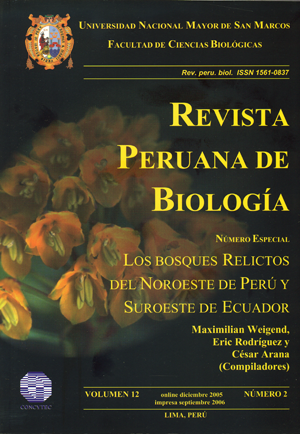Importance of landslides in Podocarpus National Park, Loja, Ecuador
DOI:
https://doi.org/10.15381/rpb.v12i2.2393Keywords:
Montane forest, landslides, pioneer vegetation, Parque Nacional Podocarpus, EcuadorAbstract
We present preliminary data on the pioneer vegetation found on natural and man-made landslides in the Parque Nacional de Podocarpus (PNP). The natural landslides selected were distributed between 2100 and 3200 m (216 study sites), while the man-made landslides were situated between 1900 and 2800 m above sealevel (216 study sites). Sampling followed Blanquet (1979) and the altitudinal gradient was used as reference. The land-slides were selected in two areas on the eastern flank (144 study sites) and in four areas on the western flank (288 study sites), totaling 432 study sites. For the natural vegetation the size of the study sites was selected according to vegetation type (herbaceous, shrubby, arboreal). The natural forest has 75 plant families, 185 genera and 412 species, 58 of the latter are endemic to the region between 2800 m and 3200 m above sealevel; natural land-slides have 56 families, 127 genera and 264 species; and man-made land-slides have 69 plant families, 127 genera and 313 species. There are no differences between the vegetation of the natural and the man-made land-slides, but rather the gradient has a direct influence on vegetation type and structure. The low herbaceous layer is the dominant feature, followed by medium-sized herbaceous plants and finally the shrub layer, especially between 2400 and 2700 m above sea-level. Within the PNP there are an elevated number of natural land-slides especially between 2200 and 2500 m above sea-level. There are some plant groups which predominate in these areas, such as Cryptogams, the herbaceous layer has some dominant plant families (Violaceae, Cyperaceae, Poaceae, Blechnaceae, Lycopodiaceae), as has the shrub layer (Asteraceae, Melastomataceae, Ericaceae, Poaceae, Aquifoliaceae), while in the natural forest other families are dominant (Asteraceae, Clusiaceae, Bromeliaceae, Ericaceae, Lycopodiaceae, Melastomataceae, Orchidaceae, Poaceae, Cunoniaceae).Downloads
Downloads
Published
Issue
Section
License
Copyright (c) 2005 Pablo Lozano, Rainer Bussmann

This work is licensed under a Creative Commons Attribution-NonCommercial-ShareAlike 4.0 International License.
AUTHORS RETAIN THEIR RIGHTS:
a. Authors retain their trade mark rights and patent, and also on any process or procedure described in the article.
b. Authors retain their right to share, copy, distribute, perform and publicly communicate their article (eg, to place their article in an institutional repository or publish it in a book), with an acknowledgment of its initial publication in the Revista Peruana de Biologia.
c. Authors retain theirs right to make a subsequent publication of their work, to use the article or any part thereof (eg a compilation of his papers, lecture notes, thesis, or a book), always indicating its initial publication in the Revista Peruana de Biologia (the originator of the work, journal, volume, number and date).






